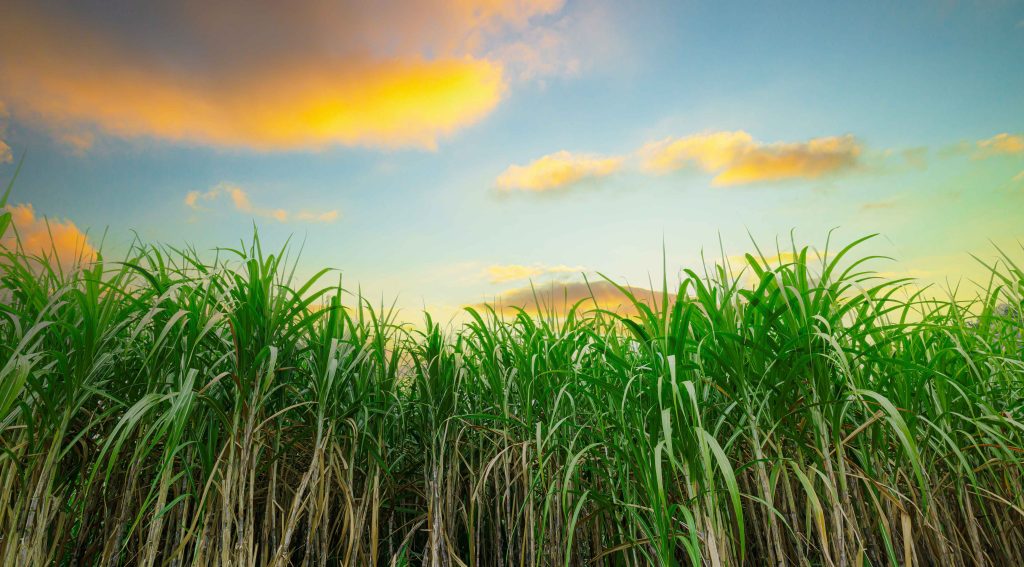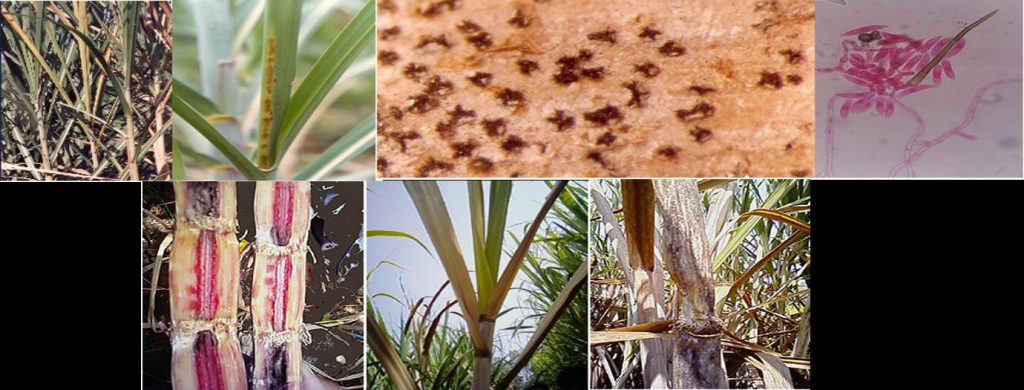
Soil Type: The best soil to farm sugarcane in Pakistan is heavy clay soil. Sugarcane grows best when there is good water drainage available.
• Land Preparation: Deep ploughing, levelling and use of Rotavator.
• Planting Season: Autumn plantation: September- October.
• Layout/Planting Method: Row Spacing: 90cm, 3 budded double setts. Seed depth: 3-5cm.
• Irrigation: 16-20 times in a season
Suitable Areas: Peshawar, Noshehra, Charsada, Mardan, Tank, Malakand, Dim Khan
Sugarcane varieties: Mardan-93, CP 77-400, SPSG 394, Mardan 2005, CP 80-1827, CP 85-1491, CP 91-582
• Fertilizers:
Plant crop: 150:100:100 kg NPK/ha. 4.5 bags DAP/ha at planting time and 5 bags SOP+2.5 bags urea/ha in March/April with 2.5 bags urea/ha at earthing up.
Ratoon Crop: 175-200:100:100 kg NPK/ha. 4.5 bags each DAP and SOP/ha with 2 bags urea/ha in March/April and 4 bags Urea/ha at earthing up.
Harvesting Season: Detail: In some areas, harvesting starts in the month of October and continues till March.
Production: 400-500 mond per acre
Sugarcane Diseases
1.Red rot (Colletotrichum falcatum.)
Identification: Red rot symptoms include drying of spindle leaves which later becomes visible in the stalks through discoloration and becoming hollow. Acervuli (black fruiting bodies) can be seen on rind and nodes of the plant.
Management
Cultural Control:
- Use resistant varieties of sugarcane
- Collect healthy seed material
- Dip the setts in an adequate fungicide solution for 15-20 minutes.
- Don’t bury the diseased stools but burn them.
- Get rid of all diseased crops.
Chemical Control: Dithane M45, Fostyl aluminium, Azoxystrobin

Fig. Red Rot of sugarcane. Top row: disease symptoms on leaves, acervuli, and hyphae. Second row: infected stalk, leaves and nodal region.
2.Ratoon Stunting Disease.
Identification:
The Ratoon Stunting Disease reduces germination in the crop which causes severe yield losses. Reduced/stunted growth, thin/short internodes, pale yellowish leaves, and rapid tapering of the stalk towards the top are few outcomes of this disease spread.
Management
Cultural Control
- Planting healthy, disease free seed cane.
- Growing resistant varieties of the crop.
Chemical Control:
- For a pathogen free seed, make use of the hot water treatment of the seed cane at about 51 degrees Celsius for 2-3 hours. However, avoid any damages from the heat treatment.

3.Sugarcane Smut (Sporisorium scitamineum.)
Identification
The disease primarily spreads through diseased setts/planting materials and by the spores the get blown by wind. Secondary spread occurs when the spores inside or above the soil surface are carried to other fields due to rain or irrigation water.
Management
Cultural Control
- Plant healthy, disease free seed cane.
- Rouging of the diseased stools should be a regular activity in the field. Collect the smut structures in plastic bags before rouging.
- Plant smut resistant varieties.
- Hot water treatment.
- Rotate sugarcane with other crops to eliminate build-up of the disease.
Chemical Control: Propiconazole, triademifon and Carbendazim

4.Sugarcane Wilt (Fusarium moniliforme and Sephalosporium sacchari.)
Identification: Look for yellowing on the midrib of the crown leaves as the remaining leaf stays green. Once the disease grows, the cane stakes are hollow and dry. On slicing an affected cane stalk in early period of infection, you can observe purple/muddy red colour on the inside, conical patches on each node just above the growth ring.
Cultural Control:
- Plant resistant varieties
- Treat seed with a good fungicide.
- Control root borer in the field as it is a precursor of this disease. Wilting attacks the injured plants by root borers.
- Regular crop rotation.
- Chemical Control: In 0.15% Emisan or 0.05% Carbendazim for 15 minutes, or 40 ppm Boran or Manganese for 10 minutes, soak the setts for 10 minutes.

Insect Pests
1.Gordaspur borer (Bissetia steniellus)
Identification:
On the leaves along the midrib in three to four rows, the females cluster 90 to 300 scale-like eggs. A single hole right above the node allows young larvae to enter the top of the cane. They create spiral galleries that travel upwards to feed in groups. They then start attacking the nearby canes after a week or ten days.

Fig.- Gurdaspur borer (from Left)- Gurdaspur pupa, Larva, infected internode, tunnel made by Gurdaspur borer, and dry tops.
2. Sugarcane top borer (Scirpophaga novella)
Identification:
The active season for this pest is from March to November. The young larvae dig into the leaf through the midrib after hatching, then into the main stem or cane stalk. As it reaches full maturity, it hibernates as a larva and the most harm is done between April and July.

Fig – Sugarcane Top Borer images- http://agropedia.iitk.ac.in/content/sugarcane-top-borer
3.Sugarcane stem borer Chilo infuscatellus)
Identfication: It poses a major threat to the sugarcane crop as well and results in losses of up to 36.5%. Years of severe infection could cause 30–70% of the damage. Every year from April to June, its caterpillars kill roughly 20% of the young shoots. After hatching, the larvae assault the plant’s roots and begin to feed there.

Fig. – Sugarcane Stem borer moth, larva, and damage
4.Root borer of sugarcane (Emmalocera depressella)
Identification: It affects sugarcane at every stage of growth. In subtropical climates, the infestation begins in May, lasts through harvest, and peaks from August to November.

Fig. – Sugarcane Root Borer. From left: dead heart and yellowing of leaves, male and female adults mating, root borer eggs, and root borer damage.
Best Control Methods of Sugarcane all Borers
- CULTURAL CONTROL
- Sowing of clean seed of improved and tolerant sugarcane varieties.
- Strong earthing up.
- Balanced fertilization.
- Irrigation at 10 days interval during April-June
- Irrigation at 20 days interval during July-September.
- Harvesting of crop at ground level.
- Mechanical Control
- Rogueing of borer infested plants during April-September.
- Biological Control
- Release of parasite and predators i.e. Trichogramma @ 20000 to 40000 parasitized eggs per acre and Chrysoperla @ 1000 to 2000 parastized eggs per acre. These should be used at 10-15 days interval during March/April to October/November.
- Chemical Control
- Apply Furadan or Curator granules @ 1-2 gm on the cut base of rogued plant (dead heart) before irrigation and 8 Kg/acre to ratoon infested plant crop before earthing up during May/June.
5. Sugarcane pyrilla (Pyrilla perpusilla)
Identification:
It causes fungal infections by sucking phloem sap from plants and excreting honeydew onto foliage. This has negative direct and indirect effects on sugar output and quality.

Fig. Sugarcane Pyrilla (from top-left: 1 and 2: Adults and Nymphs. 3. Egg Masses. 4. Feeding Punctures. 5. Honeydew. 6. Sooty Moulds. 7. Adult
Management
- Cultural Control
- Growing varieties with thin and erect leaves.
- Less ratooning.
- Trees, especially Poplar around/near the sugarcane field should not be grown.
- Avoid prolonged standing crop in the field.
- Mechanical
- Crusting of egg masses during April/May.
- Collection of nymphs/adult with hand nets and kill them.
- Burning of trash in the fields of severe infestation after harvest but leaving some in bundle nearby for the protection of natural enemies i.e. parasites and predators.
- Biological
- Release parasites/predators i.e. Epipyrops and Chrysoperla @ 1000 to 5000 per acre during April to September/October at 15 days interval.
- Chemical
- If needed, spray Lorsban 40 EC @ 1-2 liters per acre or Bifenthrin EC @ 250-500 ml per acre during April to September.
6.Sugarcane Termites (Odontotermes and Microtermes spp.)
Identification:
Sugarcane termites assault the roots after germination, consume the material, and fill the galleries with soil. As a result, plants eventually perish of leaf drying. In July, termites in sugarcane are also at their most active.
Management
- Cultural Control
- Sugarcane should not be grown on elevated dry soils.
- More irrigation should be provided in termites infested area.
- Field should be ploughed deeply at least once before planting sugarcane
- Seed rate should be increased
- Poplar trees shouldn’t be grown around and inside the field
- Avoid the use of fresh farm yard manures.
- Turmeric should be grown around the fields
- Biological
- Sugarcane should not be grown on elevated dry soils.
- Chemical Control
- Lorsban 40EC @ 500 ml should be sprayed in furrows during planting burrying the cane setts especially in September plantation.
- Fipronil 480 ml/acre
- Copper sulphate @ 3-4 Kg per acre should be applied in irrigation water.
